Click Here if you listened. We’re trying to gauge interest so only one question is required; however, there is a spot for feedback!
Read along below!
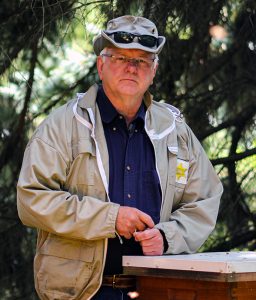 Honey Bee Husbandry in Plastic Hives
Honey Bee Husbandry in Plastic Hives
Surprisingly, beekeepers have a long plastic hive history.
By: James E. Tew
It seems to me
We all have our reasons that determine what we house our bees in. Our ancestors used box hives and the occasional skep. In all my bee life, I have primarily used ten-frame, wooden equipment. I use that kind of equipment simply because I have always used it. Some of you use eight-frame equipment. Others are eager to use top bar hives or other such related styles.
Many of you even use various types of plastic hives that are offered in multiple sizes and chemical configurations. Plastic bee hives – in one form or another – have been presented in supply catalogs at least since the late 1960’s. Honestly, plastic hives cannot really even be called a new idea.
Wood and wax
I’ve always been a wood guy. The odor of new pine wood blended with the smell of beeswax has always pervaded my beekeeping life. As the years have passed, increasingly, that smell always took me to beekeeping. Even now, the smell of newly milled pine brings back pleasant memories of new wooden bee equipment. And, of course, the odor of beeswax and combs is the classic aromas of bees’ world. These blended odors are the very essence of olfactory beekeeping.
Ironic to admit to you that I have been a woodworker longer than I have been a beekeeper. So, If I am so committed to woodworking, and spent several years building all my hive parts, why do I have any interest in plastic bee hives? Short answer – I really don’t know, but please don’t stop reading yet. I think I can explain.
Readers, this is not a comprehensive history piece…
While I believe that a thorough review of the decades-long plastic displacement of nearly everything wooden or metal in beekeeping would be interesting, that endeavor is beyond my ability and certainly beyond my space limitations here in Bee Culture. In this article, I will only be referring to plastic beekeeping events that have influenced me personally, and in fact, continue to affect me to the present time.
The Walter T. Kelley Bee Supply Company and plastic hives
I mean no omission to any manufacturer, but in my early bee life, the big three bee supply companies were: Dadant and Sons, The A.I. Root Company, and the Walter T. Kelley Company[1]. Shortly after beginning beekeeping in 1972, I realized that the Kelley Company was offering single-piece, plastic inner covers, outer covers, and bottom boards. This equipment was touted as rot-proof and maintenance-free. In 1975, three years later, Kelley added plastic hive bodies in two depths.
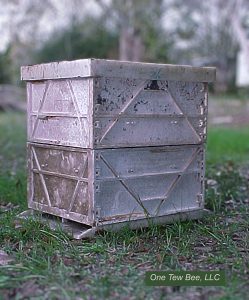
Figure 1
An old, soiled Kelley Plastic Hive, circa 1980.
There it was – a bee hive made entirely of plastic[2]. How modern! While I was dedicated to woodenware, this prominent supply company was seriously delving into plastic rather than wood as hive building materials. Though the Kelley Company maintained its wooden hive production capabilities, it was intriguing that heavy-duty, plastic hive equipment was also offered. This was a major bee supply company manufacturing plastic equipment and I admit that I was influenced by their plastic inventory offerings.
I recently spoke with a Kelley representative
A long time representative of the Kelley Company said that all the plastic hive components were manufactured for many years by several different plastic molding companies in Indiana and Arkansas. The sole piece that remains in production today is the outer cover. After so many years, why did this kind of equipment phase out of their catalog?
Through the years, the plastic molds aged and began to show wear, production companies changed, and beekeeper interest in this style of hive waned. Over time, the hard plastic hive components were dropped from the catalog.
My experience with the Kelley plastic hives was more positive than negative. Yes, the hive equipment did not “breathe” and needed more winter ventilation. Some of the pieces such as the inner cover, would slightly bow at the hand-hold spot in the middle of the inner cover. Later models of the plastic inner cover had support points to address this issue. Bottom boards also deflected some, but that issue, too, was rectified.
The equipment was rugged and weighed about the same as a comparable wooden hive body. The plastic equipment did not require painting and was wax moth and termite resistant. Since the frames were generally made from wood and beeswax, it seems to me that the bees readily accepted the plastic hive body components. Lastly, as I recall, the selling price was similar, too.
As I write this, I wonder if this plastic equipment – or any plastic equipment for that matter – could be sterilized if American foulbrood was found? I can’t answer my own question. Certainly, plastic could not be scorched with fire as has been done with wooden equipment.
My alarms are sounding
This article is not developing along the pathways I anticipated. I have mental alarms going off. Increasingly, in this piece, I am flirting with the concept of providing reviews for plastic equipment use in my apiary. That is not my intent, but how do I describe one product that I own and not mention the others that I also use? So here I am – getting in deeper and deeper as I write about plastic bee hives.
Other plastic equipment in my apiary
I presently have – and use – plastic hive components from Mother Lode, Beaver Plastics, and Bees Forever.
Mother Lode Products[3]
I have used a couple of UV Stabilized Polypropylene hive bodies from Mother Lode Products for several decades. What can I say? My pieces of this equipment have sat outside without maintenance or paint for all those years. The hive bodies have been consistently rugged and stable. The bees seem okay with them, and wax moth and carpenter ants have not been a factor.
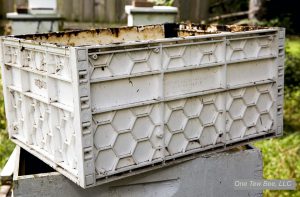
Figure 2
A decades-old Mother Lode plastic hive body.
The R-Value insulation rating simply has to be low. The plastic is nearly translucent at its thinnest points. To compensate, on their web page, the company refers to insulating panels for winter use, but I have no experience with that equipment. I post no recommendations, but after all these years, I have no complaints with my pieces of this equipment.
Beaver Plastics and Bees Forever
Two other types of equipment that have been in my apiary for many years are from Beaver Plastics [4] and Bees Forever[5]. The Beaver Plastics design is thick polystyrene, while the Bees Forever design, like the Mother Lode Products is hard plastic.
Both products are produced as a single piece molded plastic. That design generally increases shipping costs, but there is no assembly time required. The Mother Lode equipment was shipped flat so it required simple assembly.
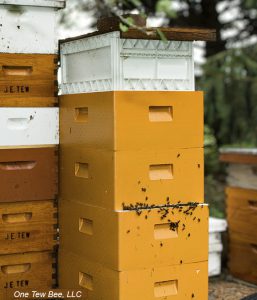
Figure 3
Two types of plastic bee equipment on the same colony (Bees Forever on top and Beaver Plastics on bottom).
Bee Max and Lyson polystyrene hive equipment
Bee Max[6] and Lyson[7] are both manufacturers of plastic bee hive systems. I do not have experience with either of them, but they are both readily available in the bee industry.
Readers, plastic equipment supplies, and abundant styles are available worldwide. Earlier in this article, I indicated that my alarms were sounding. That is still the case. With so many options and so many suppliers, I will most likely get something wrong here. The reader will have to talk to beekeeping friends and peruse the beekeeping equipment internet to make a final decision on this subject.
Bee Box[8] from Paradise Honey
I wish I could write that I had specific reasons, but honestly, I purchased enough equipment for two hives and a queen mating nucleus hive manufactured by Bee Box from Paradise Honey for mundane reasons. I made the decision to purchase this particular model simply because it was available at the moment, I had my truck with me, I had decided to purchase some polystyrene equipment, and the company would take a credit card. After several seasons of use, all has gone (mostly) well. I have used this equipment for several seasons and am comfortable providing the following conversational points.
Applying glue to joints is required
Though this unit was easy to assemble, glue must be used at the time of assembly. The same glue used to assemble wooden equipment is appropriate for assembly of this thick polystyrene equipment.

Figure 4
A cracked joint. My fault. I should have applied glue at the time of assembly.
I was eager to get bees in some of my new-fangled equipment so, without gluing, I snapped one deep together and got a colony established in it. As time passed, the joints on that unglued deep opened a bit, and the bees quickly filled those crevices with propolis. Now it will be difficult – short of complete disassembly – to make needed changes and correctly apply the glue. My lesson learned – apply glue at the time of assembly.
Painting
After assembly, I used my small airless spray paint equipment. Brushing the latex paint on would certainly have been fine, but I had the spray equipment, and it was faster than brushing. I applied two coats. On the hive bodies and supers, I taped off the contact points where the hive tool will be used. I did this not because it was necessary, but primarily because it made the final paint job looked nicer.
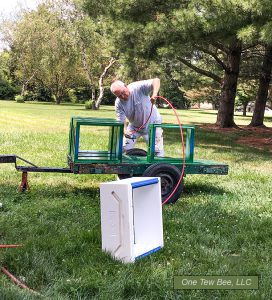
Figure 5
Painting polystyrene hive bodies with latex paint. Note blue tape application.
After beginning to use the equipment, I had problems with the paint sticking to mated surfaces of the hive bodies. I sense that this was a paint issue more than an equipment issue. I waited a couple days before using the newly painted boxes, but they still stuck together and pulled some of the paint off when I later separated the boxes. What to do the next time? Possibly coat the broad painted edges with beeswax or simply do not paint the edges at all. Any suggestions?
Hive tool use
Hive tool use must be modified – particularly when removing outside frames. If I used my hive tool to pry out a frame near the side wall, I could unintentionally put pressure on the glued corner joint. Traditional wooden equipment could easily withstand this corner stress, but when using polystyrene, more care is required. In fact, I did break a joint that connected the front with the side. I referred to this incident above.
Maybe I should have used more glue to strengthen the joints, but what I have been doing that works very well is to use a “frame Grip.” First, I break the frame free. Then using the grip with hive took assisting as needed, I remove the first frame.
Overall, when handling a full deep of bees and honey, I had a sense that this box would not withstand rough treatment or being “racked” by stressing the load on the corners. Just knowing this is enough to handle a full polystyrene box differently than I would handle a wooded deep hive body.
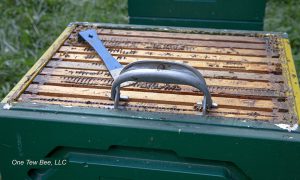
Figure 6
A frame grip and a hive tool used to remove frames. The hive tool can only be used at yellow surfaces. Note some of the green paint pulled off at the corners.
Bees and animals gnawing
I knew that under some conditions, bees will gnaw and chew the polystyrene surface and corners. To help forestall this potential problem, I chose to paint the inside of my equipment with latex paint. Others may not want to paint the inside and I understand that. Paint the inside or not – that will be your call.
Even so, most likely at some point bees and or animals are going to have a chew on this plastic. But chewing animals will also chew on wooden equipment. I consider animals chewing the equipment just to be routine “wear and tear” but what about the bees occasionally gnawing on the equipment? I have wondered if coating the inside of the polystyrene equipment with beeswax would help? (Straight up – let me say that I really doubt that I will ever try that. Too much work. If you do, I hope you will let me know how it worked out.)
Of course, under failed conditions, wax moths will chew up anything. No surprises there, but I did have some unexpected challenges having carpenter ants that constructed nests inside the thick walls of the bee boxes. They were not difficult to shake out, but the equipment was blemished by their activity.
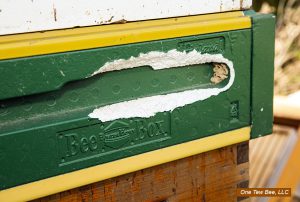
Figure 7
Animals gnawing on plastic equipment. Squirrels?
The good points
Insulation – no doubt about it. The thick walls insulate the sides and ends of the hive. To an extent, both the bottom and the top are insulated, too. Brood may be put in combs along the side wall if the colony is populous, and the brood nest is crowded. This nearly ever happens in simple wooded hive bodies.
I cannot yet say that it was wildly helpful during winter, but all other things being equal, I would expect the insulation effect to be significantly helpful. Adequate ventilation is important.
The equipment fits together nicely and, at least with the equipment I am using, I can readily interchange wooden equipment with the plastic equipment. The equipment has a snug fit and once propolis is added, the unit becomes a firmly meshed hive.
Once painted and cured, the equipment requires few concerns. A positive point with no other real place to post it is that the top feeder, once painted and installed fits snugly and is water tight without any seepage. A top feeder is shown on the polystyrene hive in the photo.
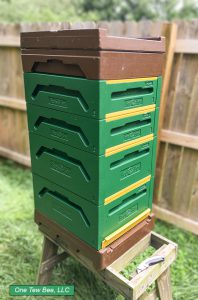
Figure 8
A polystyrene hive with a top feeder.
So, now what?
Should I use plastic equipment, or should I never use it? As is so often the case in beekeeping, the answer to that question is purely your call. I explained why I have primarily used wooden hive equipment, but the plastic equipment experience adds variety to my apiary. I like the diversity, but I truly like the smell of freshly milled pine, too.
I always appreciate you reading, thinking, and communicating with me on these subjects. It’s how we all grow. Thank you.
A bit of a discussion on this plastic hive subject
There is a discussion on pros and cons of plastic equipment, albeit a bit dated, at: https://www.beesource.com/threads/advantages-and-disadvantages-of-polystyrene-hives.320176/

Dr. James E. Tew
Emeritus Faculty, Entomology
The Ohio State University
tewbee2@gmail.com
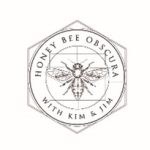 Co-Host, Honey Bee Obscura Podcast
Co-Host, Honey Bee Obscura Podcast
www.honeybeeobscura.com








